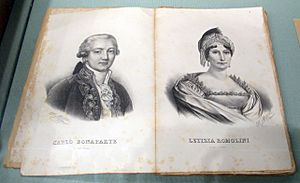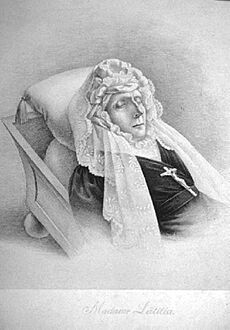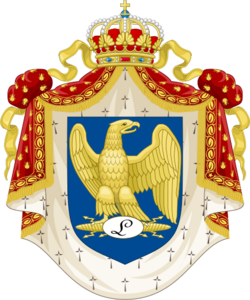Letizia Bonaparte facts for kids
Quick facts for kids Letizia Bonaparte |
|
|---|---|
| Mother of His Imperial Majesty The Emperor | |
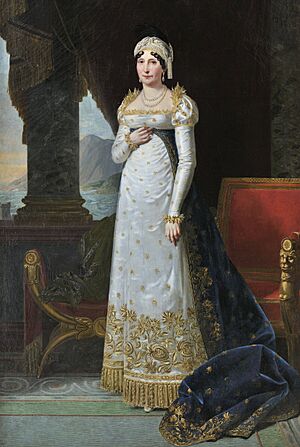
Letizia Bonaparte (Madame Mère)
by Robert Lefèvre c.1813 |
|
| Born | Maria-Letizia Ramolino 24 August 1750 (or 1749) Ajaccio, Corsica, Republic of Genoa |
| Died | 2 February 1836 (aged 85 or 86) Rome, Papal States |
| Burial | Imperial Chapel, Ajaccio, France |
| Spouse | |
| Issue Detail |
|
| House | Bonaparte |
| Father | Giovanni Geronimo Ramolino |
| Mother | Angela Maria Pietrasanta |
Maria-Letizia Bonaparte (born Ramolino; August 24, 1750 or 1749 – February 2, 1836) was a strong Corsican noblewoman. She is best known as the mother of Napoleon I, who became the Emperor of France. People often called her "Madame Mère" (French for "Madame Mother") because of her important role as the Emperor's mother.
In 1764, she married Carlo Buonaparte. They had eight children who survived into adulthood. After her husband passed away in 1785, Letizia moved to mainland France. There, her son Napoleon became very famous during the French Revolution. Letizia was always a loyal supporter of her son. She held a very important and powerful position in French society when Napoleon ruled the First French Empire. She was known for her strong will and greatly influenced Napoleon's life and career.
After Napoleon's empire ended, Letizia lived quietly in Rome. She was protected by Pope Pius VII until she died in February 1836.
Contents
Early Life in Corsica
Maria-Letizia Ramolino was born in Ajaccio, a town on the island of Corsica. At that time, Corsica was part of the Republic of Genoa. Her parents were Giovanni Geronimo Ramolino and Angela Maria Pietra-Santa. Her father, Giovanni, was an army officer who also worked on building projects. He was in charge of the Ajaccio military base. The Ramolino family was a lower-ranking noble family from Lombardy, Italy, and had lived in Corsica for 250 years.
Letizia was taught at home, mostly learning skills for managing a household. This was common for Corsican girls back then. When she was six, her father died. Her mother then married Franz Fesch, a Swiss officer, in 1757. Letizia gained two half-siblings from this marriage, including her half-brother, Joseph Fesch, who later became a Cardinal.
Marriage and Family Life
On June 2, 1764, when Letizia was 14, she married Carlo Buonaparte. Carlo was 18 and studying law in Ajaccio. His family, the Buonapartes, were also Corsican nobles with roots in Tuscany, Italy. Carlo decided to marry Letizia instead of finishing his law degree.
Letizia had thirteen children in total, but only eight of them lived past infancy. Her first son, also named Napoleon, was born in 1765 but died soon after. Then, a baby girl was born but also did not survive. Carlo later went to Rome for two years. When he returned, he joined a Corsican leader named Pasquale Paoli and worked as his secretary. During this time, Letizia became pregnant again and gave birth to Joseph on January 7, 1768.
In 1768, Corsica was officially given to France. The Corsican people, led by Paoli, fought against this. Carlo and Letizia, who was 19 and pregnant with the future Napoleon, joined Paoli. They fled with the fighters into the mountains near Corte. Letizia bravely fought alongside her husband for Corsican independence. After Paoli's forces were defeated in May 1769, the couple returned to Ajaccio.
On August 15, 1769, the day of the Assumption of Mary, Letizia was at Mass in Ajaccio Cathedral. She went into labor and, according to legend, gave birth at home on a carpet. The baby boy was named Napoleon, after an uncle who had died the year before. Letizia had trouble producing milk for Napoleon, so she hired a wet nurse named Camilla Llati. She also had one servant, Mammuccia Caterina, who helped with the children and was the midwife for Napoleon's birth. Letizia did most of the housework herself.
Letizia and Carlo became friends with the new French governor of Corsica, Charles Louis de Marbeuf. In 1777, Marbeuf helped Carlo get elected as a representative for Corsica in Versailles, France. In 1778, Carlo took Joseph and Napoleon to study in France. The next year, in May 1779, Napoleon, at age 9, was accepted into the Brienne cadet school with a scholarship. This was likely due to his parents' friendship with the governor.
Letizia stayed in Ajaccio and had six more children: Lucien (1775), Elisa (1777), Louis (1778), Pauline (1780), Caroline (1782), and Jérôme (1784). Letizia managed to visit Napoleon at Brienne in 1784, even though visits were very limited. That same year, Napoleon moved to the École militaire in Paris. Two years later, he became a second lieutenant in the army.
A Widow and Mother of a Rising Star
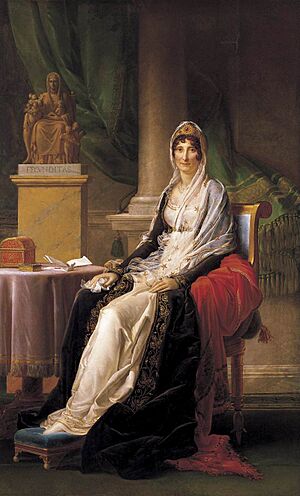
On February 24, 1785, Carlo died from stomach cancer. Letizia became a widow at 35, with eight children. Joseph, as the oldest son, became the head of the family. He returned to Corsica after finishing his studies. Napoleon also returned to Ajaccio in September 1786 and stayed for a year. The family's money situation became difficult. Letizia had four children still living at home and school fees for Jérôme and Joseph. Napoleon, as an army officer, became the main provider for the family. He returned to Corsica again in September 1789 and became involved in Corsican politics with Joseph.
In 1793, Napoleon turned against Paoli. Letizia and her other children had to flee to France on May 31. Paoli's supporters looted and burned their house. The family settled in Toulon. To avoid being recognized as nobles during the Reign of Terror, Letizia and her daughters used passports that described them as "dressmakers." A month later, the British navy took over Toulon, so the family moved to Marseilles. Letizia had no money and had to wait in line for food at soup kitchens. Her only income came from Napoleon's salary.
In the spring of 1794, Napoleon won his first big battle as an artillery commander during the siege of Toulon. He became a General. With his new income, he moved his mother and siblings to a house in Antibes. Letizia was proud of Napoleon, but she did not approve of his marriage to the widow Joséphine de Beauharnais in 1796. She was not asked for her opinion on the marriage.
When Joseph became an ambassador to the Pope in 1796, Letizia went with him to Italy. In 1797, after Napoleon's successful First Italian Campaign, she visited him in Milan with Caroline and Jérôme. Then, she moved back to Casa Buonaparte in Ajaccio, which had been rebuilt and redecorated. Napoleon allowed his mother and uncle to help manage Corsican affairs. For example, the island's leader had to ask Letizia or Fesch before making important decisions. On September 28, 1799, Napoleon returned from his successful campaign in Egypt. He stopped in Ajaccio and stayed with Letizia.
On October 7, Napoleon left for Fréjus. He was about to take power in a peaceful takeover known as the coup of 18 Brumaire, which began his rise to power. Letizia then moved to Paris. Even as the mother of the First Consul, she lived quite simply. She received a monthly payment of 25,000 francs. On November 10, 1799, while she was at the theater with her daughters, an announcement was made that an attack against Napoleon had just been stopped. Letizia remained calm and stayed until the end of the show. When her son Lucien secretly married Alexandrine de Bleschamp against Napoleon's wishes, the brothers argued. Letizia sided with Lucien and left Paris for Rome. Pauline already lived there as Princess Borghese, and Letizia stayed with her half-brother, Cardinal Fesch. Lucien and his family soon joined her.
Mother of the Emperor
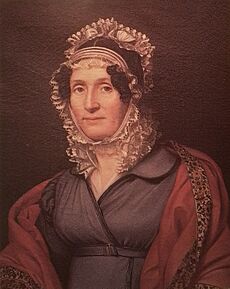
Napoleon had given his brothers and sisters important titles, but Letizia did not have an official title yet. In July 1804, Cardinal Fesch suggested to Napoleon that his mother should have a title. By official order, she was given the title "Madame." To make it clear, "Mother of his Majesty the Emperor" was added. She became known as "Madame Mère" (Madame Mother). On December 2, 1804, when Napoleon was crowned emperor, Letizia was not there. Even though she is shown in the famous painting of his coronation by David, she did not attend. When people congratulated her on her son's success, she famously replied in French: Pourvu que ça dure! (Let's hope it lasts!).
On December 19, 1804, Letizia left Rome and moved into the Hôtel de Brienne in Paris. She bought this house from Lucien for 600,000 francs. Napoleon gave her an annual payment of 500,000 francs. She did not often attend the Imperial court. From 1805 to 1813, she lived at the Chateau de Pont-sur-Seine, a castle Napoleon gave her. When she visited Paris, she stayed at her Hôtel de Brienne.
Later Life and Passing
In 1814, Letizia joined Napoleon in his exile on the island of Elba, along with Pauline. In February 1815, Letizia followed him to Paris during the Hundred Days, a period when Napoleon briefly returned to power. They met for the last time at the Château de Malmaison on June 29, 1815. After saying goodbye to her son, she traveled from Paris to Rome. There, she was protected by Pope Pius VII. She bought a large house, which was renamed Palazzo Bonaparte, where she lived with Joseph. During her years in Rome, she lived a quiet life with few visitors, except for her half-brother, Cardinal Fesch. Letizia had become very wealthy from selling her jewelry and making smart investments, which allowed her to live comfortably. For a time, the painter Anna Barbara Bansi was her companion.
Letizia died in 1836 at the age of 85. She was nearly blind by then and had lived 15 years longer than Napoleon. In 1851, her body was moved to a special Imperial Chapel built for her in her hometown of Ajaccio. In 1951, Carlo's body was brought there to rest beside her.
Children of Letizia Bonaparte
Letizia gave birth to thirteen children between 1765 and 1784. Five of them died young, two at birth and three as infants.
- Unnamed daughter (1765)
- Maria Anna Buonaparte (1767–1768)
- Joseph Bonaparte (1768–1844): He became King of Naples and King of Spain.
- Napoleon Bonaparte (1769–1821): He became Emperor of the French.
- Maria Anna Buonaparte (1771)
- A stillborn child (1773)
- Lucien Bonaparte (1775–1840): He became Prince of Canino and Musignano.
- Maria Anna (Elisa) Bonaparte (1777–1820): She became Grand Duchess of Tuscany.
- Louis Bonaparte (1778–1846): He became King of Holland.
- A stillborn son (1779)
- Pauline Bonaparte (1780–1825): She became Sovereign Princess and Duchess of Guastalla.
- Caroline Bonaparte (1782–1839): She became Queen consort of Naples.
- Jérôme Bonaparte (1784–1860): He became King of Westphalia.
Cultural Depictions
Letizia Bonaparte has been played by several actresses in films and TV shows:
- Dame May Whitty in the 1937 film [Conquet]].
- Jane Lapotaire in the 1987 film Napoleon and Josephine: A Love Story.
- Anouk Aimée in the 2002 miniseries Napoléon.
- Sinéad Cusack in the 2023 film Napoleon.
Arms


